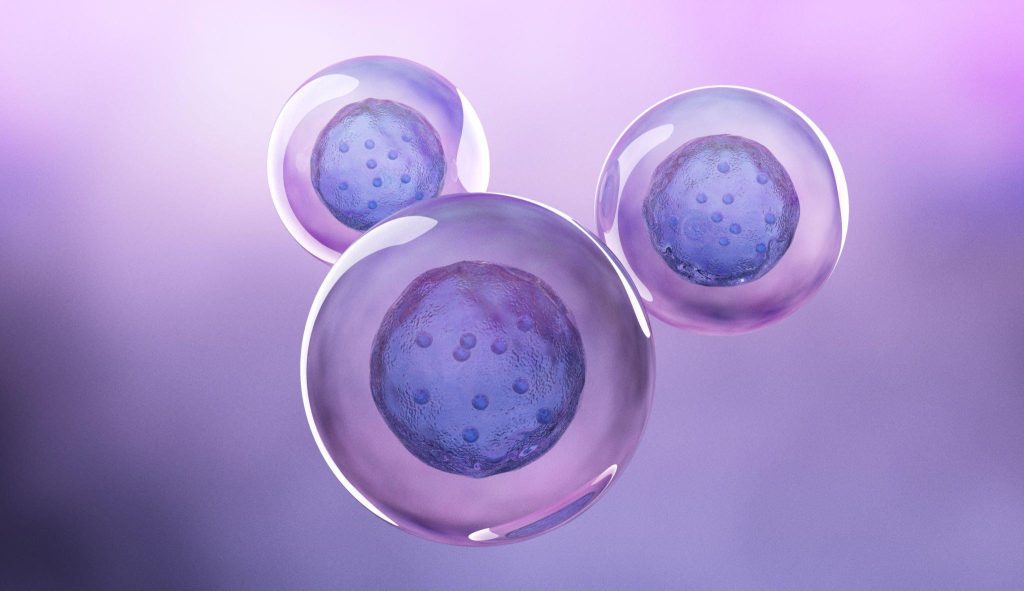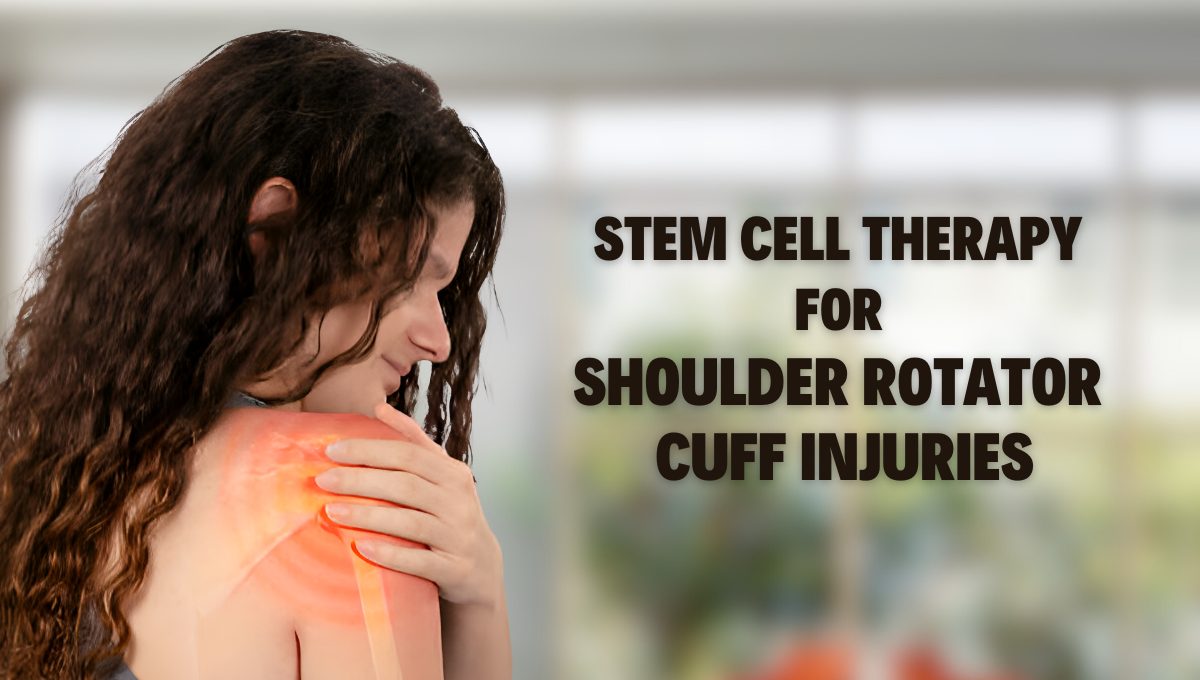How To Manage Shoulder Rotator Cuff Injuries with Stem Cell Therapy?
Is shoulder pain stopping you from engaging in your favorite activities?
Are you unable to participate in your favorite sport? Is shoulder pain delaying your business trip? Does shoulder pain not let you sleep at night?
Stem cell therapy for shoulder pain and injuries is a promising orthopedic solution and a potent alternative to surgery.
Mesenchymal stem cells sourced from human umbilical cords (Wharton’s Jelly) possess therapeutic properties. These cells are paracrine, angiogenic, and immunoregulatory.
MSCs are reliable treatment substitutes for painful shoulder surgeries. Patients who tore rotator cuffs can immensely benefit from the regenerative abilities of this non-invasive healthcare option.
Dive into the world of self-healing that rejuvenates damaged cells and alleviates shoulder injury pain with the groundbreaking stem cell therapy technique.
Table of Contents
- What is a Rotator Cuff?
- Signs and Causes of Shoulder Rotator Cuff Injuries
- Importance of Stem Cell Therapy for Shoulder Pain and Injuries
- Stem Cell Therapy vs Surgery: Which Is A Better Option To Treat Shoulder Pain?
- Who Should Choose Stem Cell Therapy for Shoulder Pain?
- Benefits of Stem Cells for Shoulder Rotator Cuff Treatment
What is a Rotator Cuff?
The rotator cuff is a group of muscles that stabilizes the shoulder joint and enables movement of the head and arms. People more than 40 years old and the elderly develop the risk of these types of injuries. It elevates the risk of developing rotator cuff arthropathy.
Common types of rotator cuff injuries result from strains, tendinitis, and tears.
Patients who went through severe rotator cuff injuries should consult with their medical experts regarding the best treatment solution.
Factors that aggravate shoulder injury chances are –
- Age – People older than 60 years are prone to suffer from these types of injuries.
- Family History – Genetical components associated with rotator cuff injuries can resurface the condition in family descendants.
- Sports-related Injuries – Several sports like basketball, baseball, javelin throw, and tennis stress the rotator cuffs and cause accidental injuries during games.
Critical rotator cuff injury cases affect people with a history of diabetes, thyroid, metabolic syndrome, and inflammatory arthritis.
Diagnosis of Rotator Cuff Injuries
Medical experts evaluate a patient’s medical history, perform physical blood tests, and conduct imaging scans.
Doctors examine the patient’s range of motion, perform X-rays, and conduct MRI scans.
These tests help to determine the severity of the rotator cuff injury.
Signs and Causes of Shoulder Rotator Cuff Injuries
Persistent pain and inflammation are common problems related to rotator cuff injuries of the shoulder. Degenerated tissues and cells in the shoulder entail several symptoms. Let us take a detailed look into the causes and symptoms separately –
Causes
The leading causes of shoulder injuries include –
- Rotator cuff tears – Persistent pain in the shoulder due to strain and torn rotator cuffs.
- Shoulder Osteoarthritis – Degradation of cells leads to depletion of the joint cartilage in the shoulder causing friction and inflammation.
- Unprecedented injuries – Activities such as heavy lifting and arm-action sports can injure the rotator cuffs in the shoulder.
- Shoulder Bursitis – Bursa is a fluid sac present in the shoulder which covers the joints. Inflammation of this area causes shoulder swelling, pain, and instability.
Symptoms
Rotator cuff injury symptoms are –
- Limited motion of the shoulders
- Frozen shoulder
- Reduced strength of rotator cuffs
- Extreme pain and disturbance in the shoulder while sleeping
- Frequent creaking sounds of the joints with a crackling sensation
- Unbearable pain while moving the arms
- Weakened arms
Importance of Stem Cell Therapy for Shoulder Pain and Injuries
Mesenchymal stem cell therapy for rotator cuff is a biological self-repair process that ensures the safe and steady regeneration of damaged cells.
These stem cells are isolated for treating shoulder injuries. MSCs can reproduce damaged cells steadily and accelerate topical and conditional healing.
Stem cells send chemical signals throughout the body to determine the distressed region, assist in the rapid recreation of damaged tissues, dissolve inflammation, repair the condition, and prevent the recurrence of degenerative diseases.
Once circulated throughout the body, MSCs begin their healing properties.
Patients with several shoulder and joint-related conditions other than rotator cuff injuries can significantly benefit from stem cell therapy.
Some shoulder-related conditions treatable with stem cell treatment include –
- AC joint separation
- Thoracic Outlet Syndrome
- Tendonosis and Tendonitis
- Recurrent dislocated shoulder
Diagnosis for Stem Cell Therapy Administration Eligibility
Before stem cell therapy is administered, medical experts need to confirm the eligibility of a patient for the treatment. Eligibility criteria –
- Personal details – Keep a note of the patient’s name, age, gender, and location.
- Medical history – Identify past medical conditions such as respiratory diseases, cardiac problems, neurological diseases, autoimmune diseases, gastrointestinal problems, and other health conditions of the patient. Additionally, find out if the patient went through any surgeries.
- Conditional symptoms – Find out the severity of rotator cuff muscle injuries and the duration of the problem with the help of blood tests and radio imaging tests.
- Lifestyle choices – Check out for the eating, drinking, and smoking habits.
[Read Also: Stem Cell Therapy for Multiple Sclerosis: The Latest Treatment Options]
Stem Cell Therapy vs Surgery: Which Is A Better Option To Treat Shoulder Pain?
Noteworthy benefits of stem cell therapy for treating shoulder pain compared to surgeries are as follows –
- No risks related to invasive approaches like surgical procedures
- No chance of stem cell rejection
- Treats severe diseases without traditional healthcare techniques or medication
- Promotes the healing of damaged tissues
Who Should Choose Stem Cell Therapy for Shoulder Pain?
Patients who fall in the following categories should give stem cell therapy a try in replacement for surgeries –
- No proper results from the medication
- Suffered rotator cuff injuries but only restricted to medication to curb symptoms instead of eliminating the root cause
- No recovery results to provide pain relief even after surgeries
- Consulted with orthopedic experts but were directed for surgeries
- Patients who were put into rehabilitation instead of surgeries or stem cell therapy
- If the patient is scared of invasive surgeries, stem cell therapy is the best solution
Benefits of Stem Cells for Shoulder Rotator Cuff Treatment
Stem cell therapy and treatment for shoulder pain is the most effective way to promote self-healing of the body and reinstate repairing abilities. Mesenchymal stem cells derived from human umbilical cord tissue are an ideal treatment compared to invasive surgeries.
The most prolific benefits of this therapy include –
- Alleviate shoulder pain with a non-surgical approach
- Avoid the complications and recovery time related to painful shoulder surgeries
- Administration of stem cells can be divided into 4-5 days sessions
- Stem cells possess anti-inflammatory, immunomodulatory, and restorative qualities to repair, replace, and regenerate damaged tissues
- Spares the pain related to autologous stem cell collection from the patient’s own body
- Improved mobility of the shoulders
- Strengthened rotator cuff joints
- No pain after the stem cell therapy session is completed
- Conditions do not resurface in the future
[Read Also: Revitalize Your Health with Advanced Stem Cell Therapy in Miami ]
Takeaway
The cost of stem cell therapy for shoulder pain varies for different individuals.
It depends on the location of the patient, the condition, the amount of dosage required for stem cell administration, the source of stem cell collection, the technique of administration, and the number of follow-up sessions.
The Life Altering Stem Cell Therapy Institute in Mexico is an American-owned and operated clinic. Our experts are clinically certified to administer stem cell treatment for a wide range of conditions. We are equipped with the latest tools and premium-quality infrastructure to attend to the needs of our patients and ensure optimal-quality
How does Stem Cell Therapy Work to Fix a Torn Rotator Cuff?
Stem cell therapy is a revolutionary approach with proven efficacy in treating orthopedic conditions, including shoulder injuries and rotator cuff tears. The human shoulder comprises a ball-and-socket joint responsible for a tremendous range of motion. The extremities in shoulder movements, such as 360-degree rotation, exert pressure on the joints, tendons, and muscles, resulting in injury. Although pain medications and proper rest can treat minor tears, chronic cases need proper medical attention to avoid long-term difficulties.
Surgery is a conventional treatment for torn rotator cuffs resulting from sports injuries or accidental falls. However, it poses risks of side effects and post-surgery complications. Stem cell therapy is a new and innovative treatment for shoulder pain caused by rotator cuff tears, tendonitis, shoulder arthritis, and others. Let’s discuss how the therapy works, its potential advantages, and post-treatment recovery.
Table of Contents
What is a Rotator Cuff Tear?
Rotator cuff tear is a type of shoulder injury involving a tear in the tissues connecting muscles to bones around the shoulder joint. Common symptoms include intense pain, difficulty moving the shoulder, and progressive weakness in the affected muscles.
Rotator cuff strains are caused by excessive wear and tear over time, acute injury, and overuse. Furthermore, the intensity of the injury might range from mild to severe. Rotator cuff tears are most likely to impact tennis players who serve overhead and anyone experiencing strain or tear after a car accident, fall, or sudden injury.
Advanced Stem Cell Therapy to Fix a Torn Rotator Cuff
Long-term overuse of the shoulder is one of the primary reasons for rotator cuff tears. People at risk for this degenerative injury include athletes and workers in lifting jobs. Stem cell therapy is a promising non-surgical treatment that can repair damaged tissues and enhance the body’s natural healing capabilities.
Stem cells have the unique potential to differentiate into any cell type and promote tissue regeneration. Stem cell therapy for shoulder pain utilizes the regenerative potential of the cells to regrow healthy tissues and replace the damaged tissues in the injured shoulder. It is a novel regenerative approach serving as an effective alternative to shoulder surgeries or other conventional treatments.
Stem cell treatment supports the body’s repair mechanism and promotes healing naturally from within. For example, in the case of rotator cuff tears, stem cells renew healthy cells in the bones and muscles and improve blood flow at the injury site.
Read Also: Healing Power Of Stem Cell Therapy: A Comprehensive Guide
Benefits of Stem Cell Therapy for Shoulder Pain due to Rotator Cuff Tears
Compared to harsher surgical treatments for rotator cuff tears, stem cell therapy is a better alternative as it is minimally invasive with a shorter recovery period. It is, therefore, a safe and viable option for athletes to enhance recovery from the injury. They can regain range of motion and optimize performance through natural healing.
Stem cell therapy is an effective treatment option for rotator cuff tear symptoms and to promote recovery. Injecting stem cells into the affected joints offers numerous benefits.
- It is a non-surgical and less invasive medical procedure that doesn’t require any incision or cut on the skin.
- Stem cells repair the damaged tissues and regrow healthy cells, reducing inflammation and pain.
- Stem cell therapy effectively restores shoulder function and improves its range of motion.
- Stem cells reduce scar formation and prevent further wear and tear of the cartilage in the affected shoulder.
- The newly introduced stem cells release growth factors and act on the surrounding tissues to restore a healthy environment for healing.
Post-treatment recovery
Compared to surgery, cell-based therapy supports faster recovery and reduces downtime. It is an outpatient procedure that doesn’t require prior hospitalization. With restricted shoulder movements, one can resume a normal routine within one or two days of the treatment.
In most cases, doctors recommend physiotherapy to support stem cell treatment. This enables healthy blood flow to the diseased area and promotes faster recovery from the damage. Patients need to attend regular follow-up sessions with the concerned doctors, who inform them about the progress and improvements in their symptoms.
Recovery time may vary from person to person since every individual is different. Some might need more time to heal, while others might return to an everyday and active life sooner. However, one must avoid strenuous activities that might impact the treated area by imposing pressure.
Although stem cell therapy doesn’t require lengthy rehabilitation, patients need time to restore the range of motion and mobility in the treated joints.
Read Also: Stem Cell Therapy For Myocardial Infarction: A Therapeutic Hope
Which is the best institute for stem cell therapy for rotator cuff repair?
Numerous stem cell therapy clinics offer regenerative medicine treatment worldwide for various orthopedic conditions, including rotator cuff tears. Mexico is one of the best places for medical tourism, known for its advanced treatment technologies and robust healthcare system. Moreover, it is home to esteemed medical professionals and stem cell experts, making it easier for patients to access cutting-edge stem cell treatments.
Life Altering Stem Cell Therapy Institute is a reputed clinic that provides affordable stem cell therapy in Mexico. Patients can get advanced treatments for various medical conditions, including orthopedic injuries, autoimmune diseases, neurological disorders, fertility issues, and age-related problems.
You can fill out our patient application form or book a consultation with our expert to determine whether you are eligible for stem cell therapy for a rotator cuff tear. Our healthcare professionals have a proven record of successfully treating orthopedic conditions like knee, back, and shoulder pain and rotator cuff tears. Our stem cell center in Mexico ensures smoother recovery of our patients with holistic treatment and compassionate care.
Final thoughts
Stem cell therapy for rotator cuff tears is a novel treatment that utilizes stem cells of the patient’s body or donors to address the pain and inflammation. It is a safe, non-surgical procedure without complications or adverse side effects. Most treatment centers use human umbilical cord tissue-derived mesenchymal stem cells (HUCT-MSCs) to avoid the ordeal of collecting cells from the patient’s bone marrow or adipose tissue. HUCT-MSCs are new cells extracted from the umbilical cords of newborn babies after healthy births, which eliminates the chances of cell rejection.
Stem cell interventions ensure an easy journey of recovery for patients suffering from a torn rotator cuff. They aid in the natural healing of the injured area through tissue repair and regeneration. The therapy shows a path towards a healthier and pain-free tomorrow.
Revolutionizing Relief: Mesenchymal Stem Cells Break the Chains of Chronic Back and Neck Pain
In the realm of regenerative medicine, mesenchymal stem cells (MSCs) have emerged as a beacon of hope for individuals grappling with chronic back and neck pain. This groundbreaking therapy offers a promising avenue for relief, showcasing the potential to transform lives and redefine the landscape of pain management. In this comprehensive guide, we delve into the intricacies of using mesenchymal stem cells to alleviate chronic back and neck pain, shedding light on the science behind the therapy and its potential to revolutionize the way we approach persistent musculoskeletal discomfort.
Understanding Chronic Back and Neck Pain:
Chronic back and neck pain are prevalent afflictions that impact millions worldwide, significantly impairing quality of life. Conventional treatments often provide only temporary relief, leaving individuals searching for more sustainable and effective alternatives. Stem cell therapy, particularly with mesenchymal stem cells, is emerging as a revolutionary approach that aims not just to manage symptoms but to address the root causes of pain.

Mesenchymal Stem Cells: Nature’s Healing Architects:
Mesenchymal stem cells, found in various tissues throughout the body, possess a remarkable ability to differentiate into diverse cell types. This inherent versatility makes them a potent tool in regenerative medicine. These cells can be sourced from different tissues, such as bone marrow, adipose (fat) tissue, and umbilical cord tissue. Harnessing the regenerative potential of MSCs opens new possibilities for treating a myriad of conditions, including chronic back and neck pain.
The Science Behind Mesenchymal Stem Cell Therapy:
Mesenchymal stem cells exert their therapeutic effects through multiple mechanisms. They have immunomodulatory properties, meaning they can modulate the immune system’s response, reducing inflammation and promoting tissue repair. Additionally, MSCs release bioactive molecules that stimulate local cells, fostering regeneration and tissue healing. These attributes make them an attractive option for addressing the degenerative processes underlying chronic back and neck pain.
Targeted Treatment: Stem Cell Therapy for Shoulder Pain:
While our primary focus is chronic back and neck pain, it’s essential to acknowledge the interconnected nature of musculoskeletal health. Many individuals suffering from chronic back pain also experience shoulder pain, creating a holistic approach to treatment. Mesenchymal stem cells can be precisely administered to target affected areas, providing a comprehensive solution for those dealing with the dual challenges of back and shoulder pain.
The Procedure: A Glimpse into Stem Cell Treatment for Back Pain:
Stem cell therapy for chronic back and neck pain involves a minimally invasive procedure. After harvesting the patient’s stem cells or utilizing an allogeneic source, the MSCs are prepared and then strategically injected into the affected area. This targeted delivery ensures that the therapeutic effects are concentrated precisely where they are needed most. The outpatient nature of the procedure allows for a quick recovery, minimizing downtime for individuals seeking relief from the burden of persistent pain.
Clinical Efficacy: Unveiling the Results:
Numerous clinical studies have explored the efficacy of mesenchymal stem cell therapy for chronic pain conditions. Patients undergoing stem cell treatment for back pain have reported significant improvements in pain levels, functional mobility, and overall quality of life. The regenerative potential of MSCs offers a beacon of hope for those who have exhausted traditional treatment options.
Addressing Safety Concerns:
Safety is a paramount consideration in any medical intervention. Mesenchymal stem cell therapy, when performed by qualified healthcare professionals in controlled environments, has demonstrated a favorable safety profile. Rigorous screening and quality control measures ensure that the cells used in therapy meet stringent standards, minimizing the risk of adverse effects.
Personalized Medicine: Tailoring Treatment for Individual Needs:
One of the hallmarks of mesenchymal stem cell therapy is its adaptability to individual patient needs. The treatment protocol can be personalized based on factors such as the patient’s overall health, the severity of the condition, and the specific characteristics of the pain. This personalized approach enhances the likelihood of positive outcomes, emphasizing the commitment to patient-centric care.
The Future of Pain Management: A Paradigm Shift:
As we navigate the evolving landscape of pain management, mesenchymal stem cell therapy stands out as a potential game-changer. Its regenerative capabilities, combined with its minimal invasiveness and safety profile, position it as a frontrunner in the pursuit of long-lasting relief for chronic back and neck pain. The ongoing research and advancements in stem cell science hold the promise of refining and expanding the applications of this transformative therapy.
Conclusion:
In the quest for relief from chronic back and neck pain, mesenchymal stem cell therapy emerges as a beacon of hope, promising not just to alleviate symptoms but to instigate a transformative healing process. The versatility of these cells, coupled with their regenerative potential, opens new doors for individuals trapped in the cycle of persistent pain. As science propels us into the future of medicine, mesenchymal stem cells illuminate a path towards a brighter, pain-free tomorrow.





